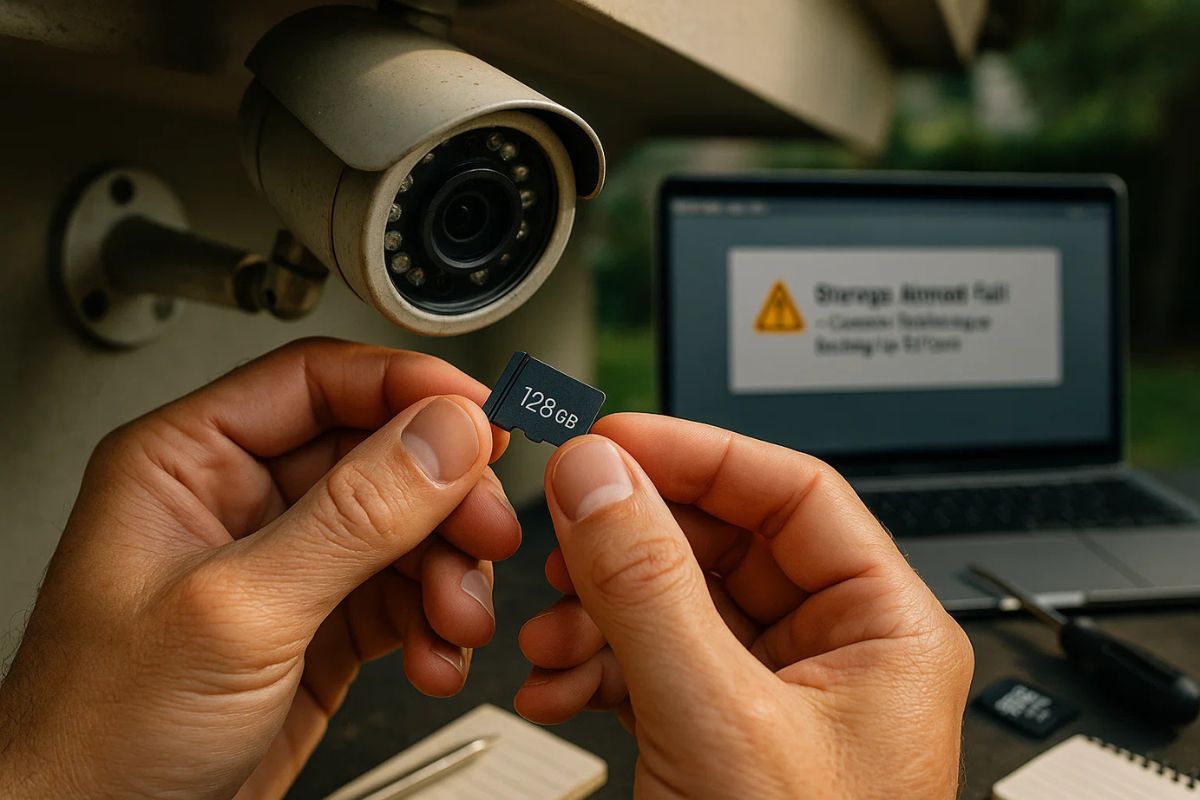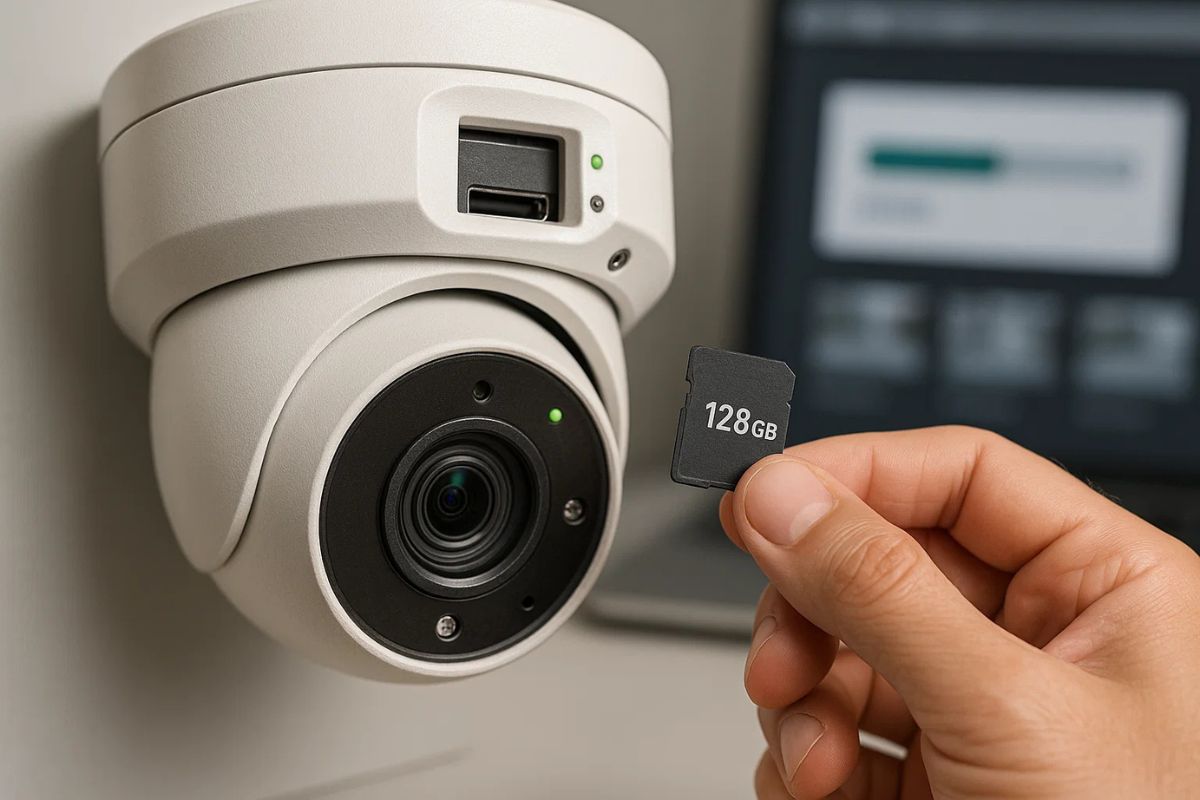Bullet vs. Dome CCTV Cameras
When selecting a CCTV camera, understanding the structural and functional differences between bullet and dome cameras is essential. Each type serves specific purposes, excels in certain environments, and comes with a distinct set of features. Below, we explore their characteristics in depth, helping you decide which suits your surveillance goals.
What Is a Bullet CCTV Camera?
Design and Shape
A bullet CCTV camera is instantly recognizable due to its elongated cylindrical body, resembling a bullet or a tube. This shape is not just for aesthetics; it’s engineered for directional surveillance, allowing users to point the camera at a specific area for long-distance monitoring. For those looking to enhance their property’s protection, a reliable security camera setup ensures optimal coverage and peace of mind.
Ideal Use Cases
Because of its form factor, a bullet camera is often mounted on walls or poles. It’s most effective in areas where you want to cover a narrow field of view with precision. Common locations include driveways, parking lots, perimeters, building entrances, and hallways.
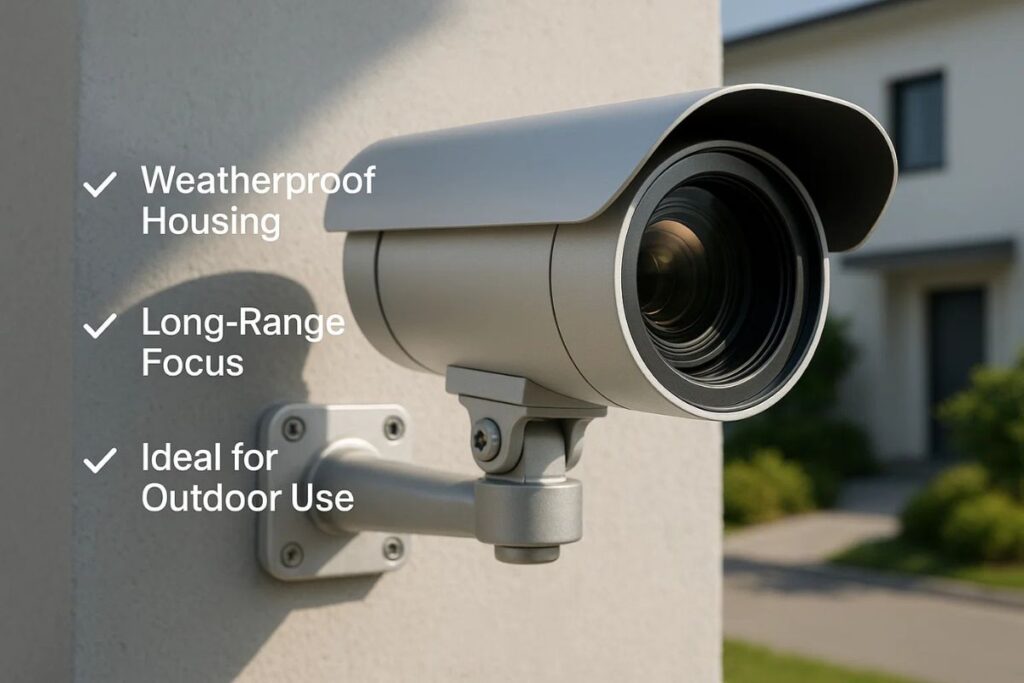
Outdoor Suitability
Most bullet cameras are built for outdoor use, featuring weather-resistant casings and long-range lenses that make them resilient in rain, dust, or direct sunlight. Their visible presence also serves as a deterrent to potential intruders, offering a psychological layer of protection. For complete property protection, you can also hire Security Alarm System Installation in Melbourne to integrate alarms with your surveillance setup.
Performance Features
Bullet CCTV cameras are known for their ability to monitor over long distances. They usually include:
- High-resolution sensors (HD, 2K, or even 4K)
- Infrared night vision for effective 24/7 surveillance
- Adjustable mounting brackets for precise camera angles
- Optional zoom lenses for enhanced detail recognition
What Is a Dome CCTV Camera?
Dome-Shaped Design
As the name suggests, dome CCTV cameras come in a compact, dome-shaped housing, typically installed on ceilings. This shape offers a modern and discreet aesthetic, blending well in indoor environments without drawing too much attention.
Ideal Environments
Dome cameras are best suited for indoor surveillance, especially in areas like offices, retail stores, hotel lobbies, restaurants, and other indoor public or commercial spaces. They offer wide-angle coverage, making them effective for monitoring larger open spaces.
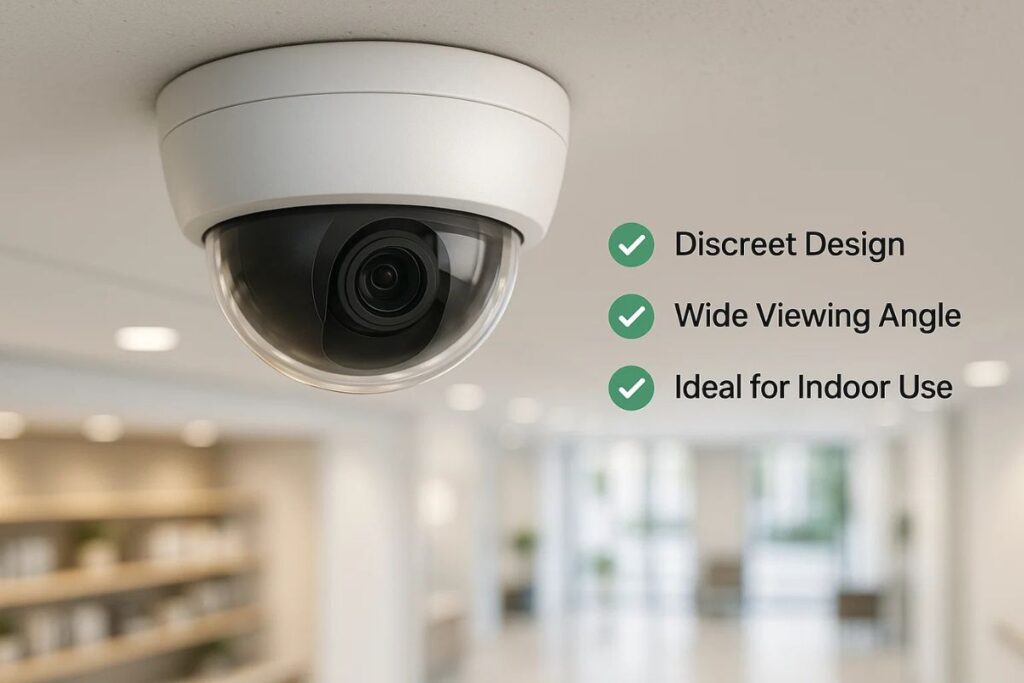
Stealth Advantage
One of the biggest advantages of dome cameras is their surveillance ambiguity. The tinted or reflective dome makes it difficult for people to see exactly where the lens is pointing, which helps reduce blind spots and enhances stealth monitoring.
Versatility and Protection
Though typically used indoors, many dome cameras are available in vandal-resistant or weatherproof models. Features often include:
- Wide field of view
- Compact and discreet design
- High vandal resistance, especially with vandal dome models
- Compatibility with indoor and outdoor setups (depending on IP rating)
Comparing Bullet and Dome CCTV Cameras
Physical Appearance and Mounting Style
Bullet cameras are more prominent and usually mounted on walls, while dome cameras are compact and designed for ceiling installation. This makes dome cameras better suited for discreet indoor monitoring, whereas bullet cameras are ideal for outdoor surveillance and visible deterrence.
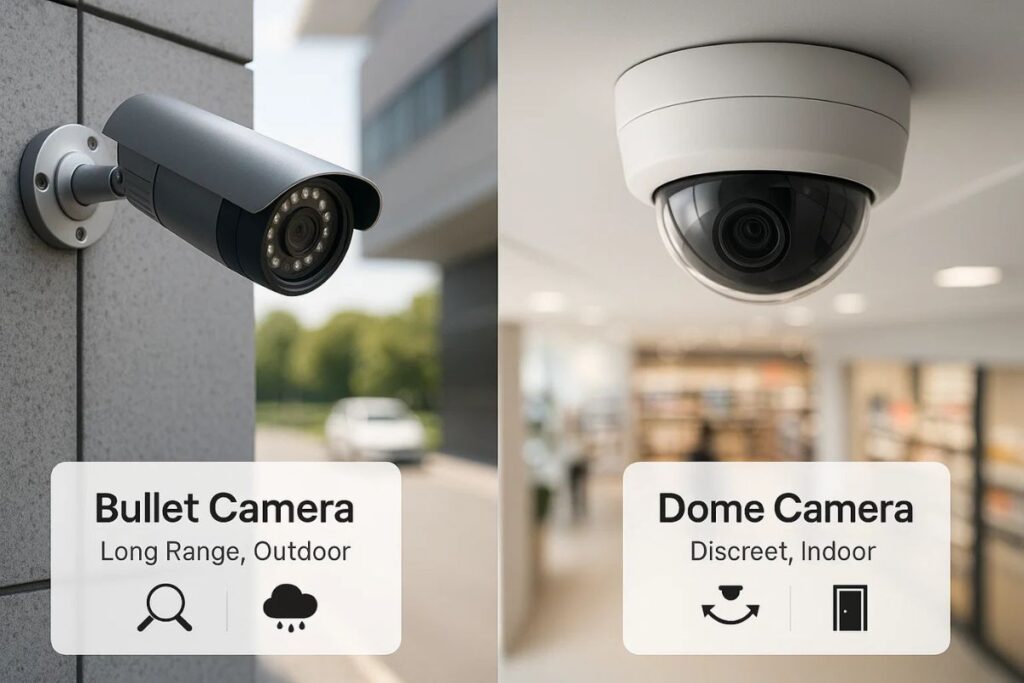
| Feature | Bullet Camera | Dome Camera |
| Shape | Cylindrical (bullet-like) | Dome-shaped (semi-spherical) |
| Visibility | Highly visible (acts as a deterrent) | More discreet and less noticeable |
| Mounting Style | Typically wall-mounted | Typically ceiling-mounted |
| Best Use | Long-range, focused outdoor monitoring | Wide indoor coverage with stealth |
| Weather Resistance | Often IP66/67-rated for harsh weather | Varies; some are outdoor-capable |
| Camera Direction | Easily identifiable | Hidden within the dome |
| Vandal Resistance | Moderate | High (especially vandal domes) |
Visibility and Surveillance Strategy
If your goal is to scare off potential intruders, bullet cameras are highly effective due to their visible presence. On the other hand, if stealth and subtlety are important, such as in customer-facing businesses, dome cameras offer an edge.
Directional Monitoring vs. Wide-Area Coverage
Bullet cameras are engineered for long-range, fixed-point monitoring, which is perfect for corridors or perimeter areas. In contrast, dome cameras are designed for wide-angle views, suitable for monitoring open areas where camera movement isn’t always needed.
Durability and Tamper Resistance
Dome cameras, especially vandal-proof variants, offer better resistance to physical damage, making them suitable for environments where the camera might be within reach. Bullet cameras, while durable, are generally more exposed and easier to tamper with.
Battery Life Considerations
Power Consumption Differences
While both bullet and dome CCTV cameras can be wired, wireless, or battery-operated, power consumption may vary slightly based on design and usage. Bullet cameras often feature higher-resolution lenses and longer IR ranges, which can result in greater battery usage, especially in outdoor or high-traffic zones.
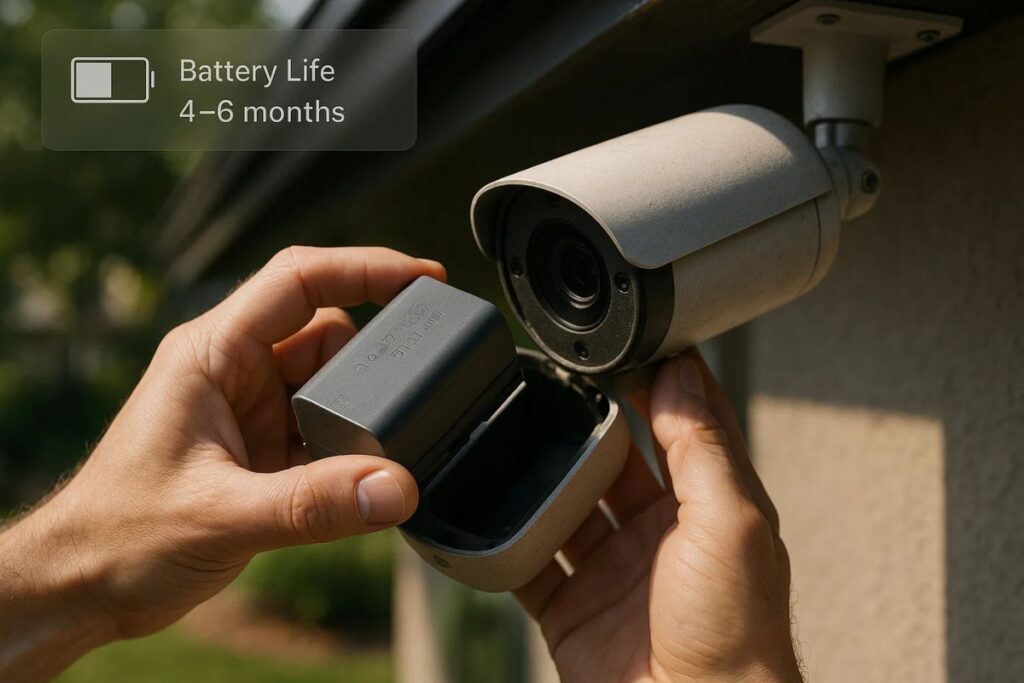
Efficiency in Indoor Environments
Dome cameras, when used indoors, typically operate in lower-activity settings, leading to more power-efficient performance. However, factors such as recording mode (continuous vs. motion-triggered), connectivity strength, and ambient lighting have a more significant impact on battery life than the camera type alone.
Which One Should You Choose?
Choose Bullet Cameras If…
- You need long-range surveillance in outdoor areas.
- Visibility is part of your deterrence strategy.
- You require focused, directional monitoring for specific entry points.
- You plan to install cameras on walls or poles.
Choose Dome Cameras If…
- Choose Dome Cameras If… you want a discreet look that blends with interior decor, need to cover large indoor spaces like lobbies or stores, or are concerned about vandal-resistance in public-access areas where ceiling installation works best. For a reliable, high-quality security solution that complements your dome cameras, consider buy Dahua IP Intercom Kit 900 to enhance your home or business surveillance system..
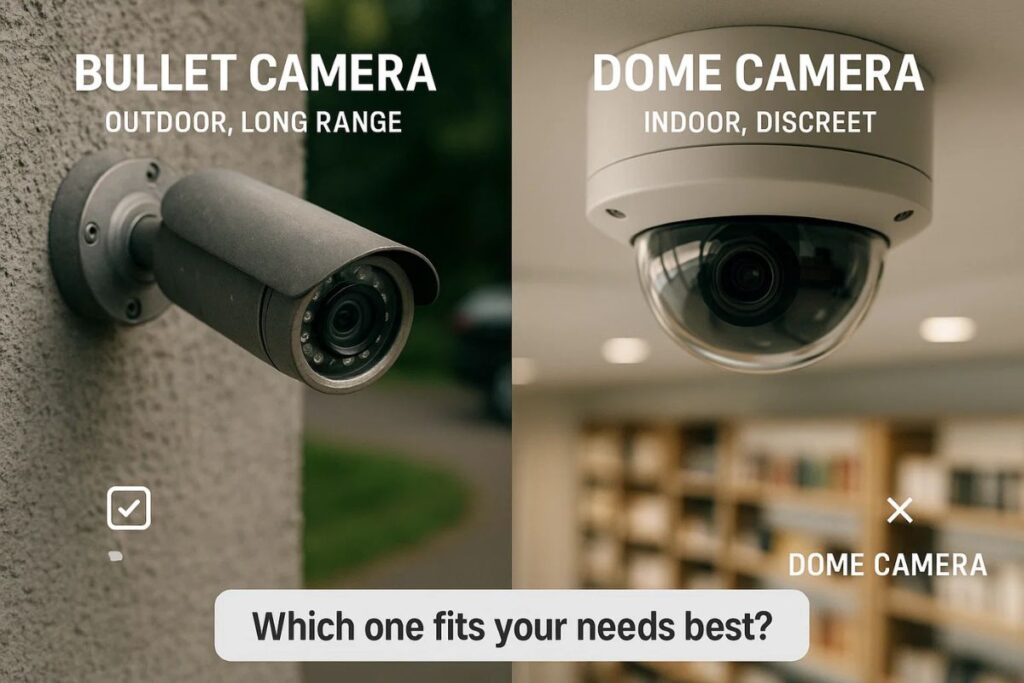
Final Thoughts
Both bullet and dome cameras offer advanced security features and are available in wired, wireless, and battery-powered variants. The right choice depends on your specific environment, aesthetic preferences, and surveillance goals. While bullet cameras are perfect for outdoor, long-range use, dome cameras excel in indoor, wide-area monitoring with a low-profile design. To ensure complete protection, you can hire CCTV surveillance camera installation experts in Melbourne to upgrade your property with a reliable security alarm system for enhanced safety and peace of mind.



